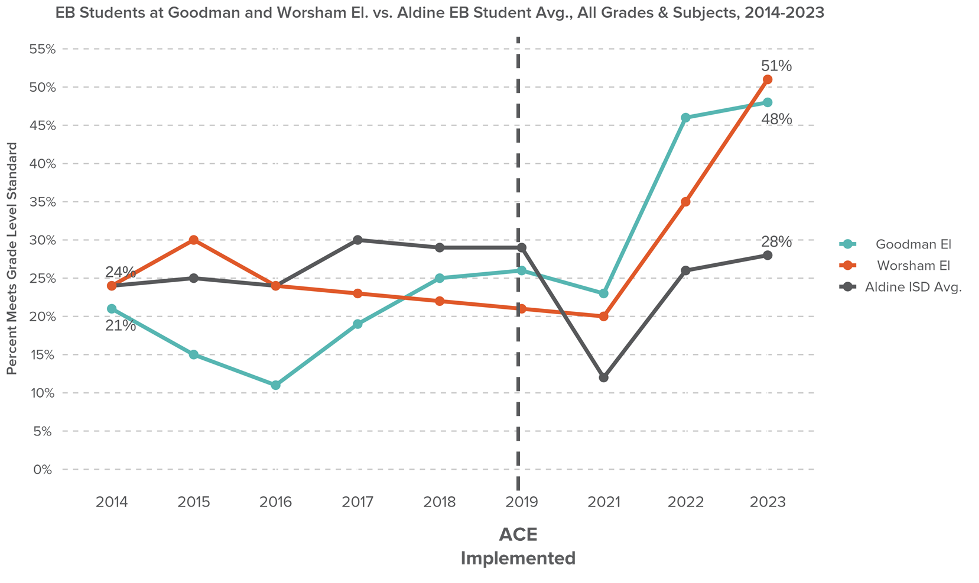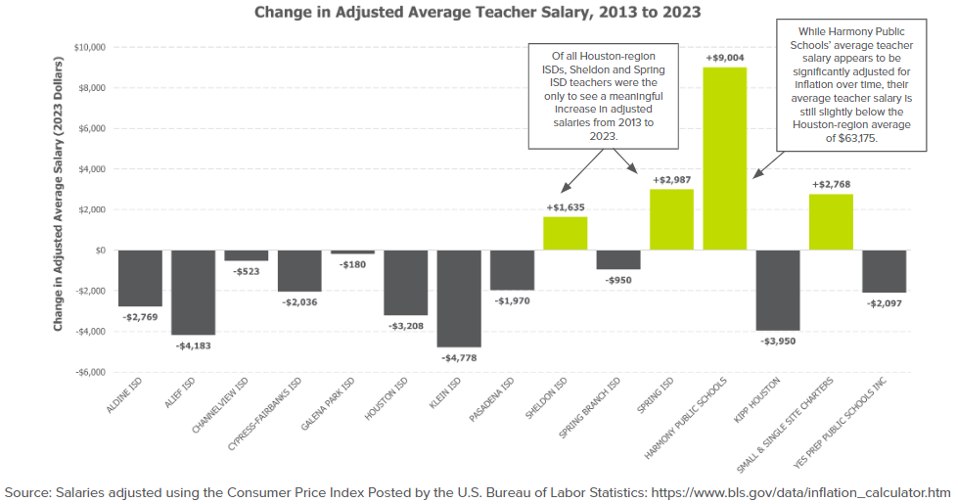Dear Partner,
Welcome back to Houston ConnectEd, Good Reason Houston’s monthly series spotlighting important education data research and trends.
As the end of the school year draws near, we want to build on our current Schools That Inspire campaign to highlight some incredible work being done for students in one of our school district partners, Aldine ISD. As districts work through next school year’s annual planning and budgeting processes, we hope to see them introduce bold initiatives that drive change for students at a scale and pace students deserve. Aldine ISD implemented transformation efforts in two of its elementary schools that have experienced growth that has outpaced other interventions in the region. Read on as we unpack the results we’re seeing from the introduction of the Accelerating Campus Excellence (ACE) model. Even more, let’s look ahead at a new school to be launched to support Aldine’s career-connected learning efforts.
As you have questions or thoughts on the work highlighted here, please reach out to us at info@goodreasonhouston.org, or join us on social media using #HTXConnectEd.
Sincerely,

In this email, we’ll provide you with:
Elementary School Spotlight | Recent Initiatives | Data in the News
Celebrating Goodman and Worsham Elementary Schools
In 2019, Aldine ISD implemented the Accelerating Campus Excellence (ACE) model at two elementary school campuses, Goodman Elementary and Worsham Elementary. ACE is a turnaround strategy that empowers district and school leaders to drastically reset and improve instruction and school culture at historically underperforming schools. The model holds five pillars at its core: Strategic Staffing, Instructional Excellence, Extended School Day, Social and Emotional Learning, and Parent and Community Engagement.
Good Reason Houston has worked side-by-side with district leaders to plan, implement, and track the ACE model. We are pleased to report that, thanks to the hard work and commitment to implement the ACE model on the part of district and campus-based staff, students at these two historically underperforming campuses have thrived in recent years.
As seen in the graph below, prior to the implementation of ACE in 2019, Goodman and Worsham typically saw students scoring the same as or worse than those elsewhere in Aldine ISD. Since 2019, however, these two campuses have seen tremendous growth on State of Texas Assessments of Academic Readiness (STAAR) exams compared to the rest of the district.

The COVID-19 pandemic greatly disrupted education across the nation and here in Houston, but students at Goodman and Worsham saw smaller declines in STAAR from 2019 to 2021 than students at other Aldine ISD schools. They also experienced much more significant growth from 2021 to 2023 (note that STAAR exams were not administered in 2020 due to the pandemic).
This trend held true for student groups who have historically faced academic challenges as well. The figure below demonstrates that emergent bilingual (EB) students have thrived at Goodman and Worsham relative to their EB peers elsewhere in Aldine ISD. Similarly, Black students at Goodman Elementary were about 1.5x more likely to meet 2023 grade level STAAR standards than the average Black student in Aldine ISD (Worsham Elementary does not have a large enough Black student enrollment for comparison).

Good Reason Houston applauds the efforts of the Aldine ISD district personnel and the dedicated campus leaders and staff of Goodman and Worsham who made this incredible progress possible. We hope that these two schools can serve as examples for the rest of the Houston region as they consider what’s possible through dedicated, meaningful change.
Leveraging Teacher Incentive Allotment to Compensate Great Teachers
In June 2019, the Texas Legislature passed House Bill 3, which, among other things, established the Teacher Incentive Allotment (TIA). Districts across the state can apply for TIA to provide additional funding to boost the salaries of the district’s highest performing teachers, particularly those serving at high-need campuses. Aldine ISD applied for and was approved as a TIA district starting with the 2022-2023 school year. Since then, the district has pulled down significant additional funding from the state. This funding incentivizes the most impactful educators to teach at the schools which need their talents most. Increasing teacher salaries in Aldine ISD–particularly in high-need schools–is especially imperative, given that inflation-adjusted teacher salaries fell in the district from 2013 to 2023 by nearly $2,800, as seen in the graph below.

New School Opening: HEAL
Earlier this year, Aldine ISD announced the launch of a first-of-its-kind partnership between the district and Memorial Hermann Health System to create a career technical education (CTE) high school focused specifically on preparing students for high-wage, high-demand careers in health. The new Health Education and Learning High School (HEAL), slated to open in fall 2024, will create a direct connection between the K-12 education system and one of the region’s most vital employers, providing students with specialized curriculum, work-based learning, and the opportunity to earn credentials and certifications of value. HEAL will serve about 760 students at full capacity, and graduates will have immediate access to employment within the Memorial Hermann system.
Across the Houston region, as seen in last month’s Houston ConnectEd, the proportion of high school graduates obtaining credentials of value–including professional certifications, associate’s degrees, or bachelor’s degrees–within six years of high school graduation remained flat from the graduating classes of 2012 to 2017 at a mere 27%. This despite the fact that experts estimate that at least 70% of jobs in Texas will require such credentials by 2036. Such a stark gap emphasizes the urgency of an opportunity presented by initiatives such as HEAL.

This initiative was made possible by a $250 million initiative of Bloomberg Philanthropies to more directly connect the health and education systems in 10 communities across the country. Aldine ISD and Memorial Hermann entered into a competitive application process in receiving their initial $31 million award from Bloomberg Philanthropies, and Good Reason Houston staff provided expertise and technical assistance throughout the application process.
We are thrilled to highlight the incredible opportunity this initiative represents for Aldine ISD students, and for the Houston region as a whole. We hope that this direct connection between K-12 education and employers in high-growth, high-wage industries can serve as a model for other school systems as they consider how best to prepare their students to be able to lead meaningful, choice-filled lives after high school graduation.
Data in the News
Here are some of the education-data news items we’ve been keeping our eye on over the past few weeks.
What’s the Right Goal for Student Achievement?: School systems are continually setting goals around student achievement, but it’s often unclear how to set reasonable and attainable benchmarks. Is 50% of students meeting grade level standards a high enough expectation? What is meaningfully different if we instead set the bar at 55%? This article suggests setting goals based on the future needs of a skilled workforce.
Survey Finds Many Gen Zers Say School Isn’t Motivating and Lacks Purpose: A recent national survey of Gen Zers ages 12-18 found that less than half of current middle and high school students feel motivated to go to school or work, and barely half believe they do important things at school or work. This highlights the urgent need for our school system to find ways to meaningfully engage their students and provide value to them, both in the short- and long-term.
Schools Are More Segregated than 30 Years Ago, But How Much?: A new study examines the extent to which schools have resegregated since the 1990s, finding that children’s exposure to children from other racial or ethnic groups has decreased slightly since that time. However, because the country is much more diverse than it was prior to the landmark Supreme Court decision Brown v Board of Education (1954), school segregation remains much lower than it was before Brown. This decision, which forever changed American education for the better, celebrated its 70th anniversary on May 17th.


